8-Week 10K Treadmill Training Plan (UK) for Beginners to Intermediates
8-Week 10k Treadmill Training Plan (UK) for Beginners to Intermediates
Reading time: 14 minutes | Last updated: September 2025
If you want to run a confident 10k without worrying about weather, traffic, or daylight, this 10k treadmill training plan is for you. Built for UK home runners from beginner to intermediate level, it gives you a clear 8-week path to improve endurance, pace, and confidence—entirely indoors. Expect simple session structures, realistic progressions, and evidence-led tips for staying injury-free.
- Can you train for a 10k entirely on a treadmill? Yes—use a 0.5–1% incline to better mimic outdoor effort.
- How many days per week? 3–4 runs, plus optional cross-training and strength.
- How long is the plan? 8 weeks, with deloads to manage fatigue.
- How to pace? Use RPE (perceived effort) or heart-rate zones; see guidance below.
TL;DR
- Three to four runs per week: one easy, one quality (intervals/tempo), one long run, plus optional recovery jog or cross-training.
- Set 0.5–1% incline to approximate outdoor conditions; adjust up to 2–3% for hill repeats.
- Warm up 8–12 minutes; cool down 5–10 minutes; include two short mobility blocks weekly.
- Progress gradually: increase long-run time by 5–10 minutes most weeks; reduce volume in Week 4.
- Use RPE 3–4 for easy runs, 6–7 for tempo, 8–9 for short intervals; keep quality days separated by easy days.
- Fuel longer sessions with a light carb snack; prioritise 1.2–1.6 g protein/kg/day for recovery (NHS Eatwell guidance).
- If joints are sore or you need variety, cross-train with a rower or cross-trainer on easy days.
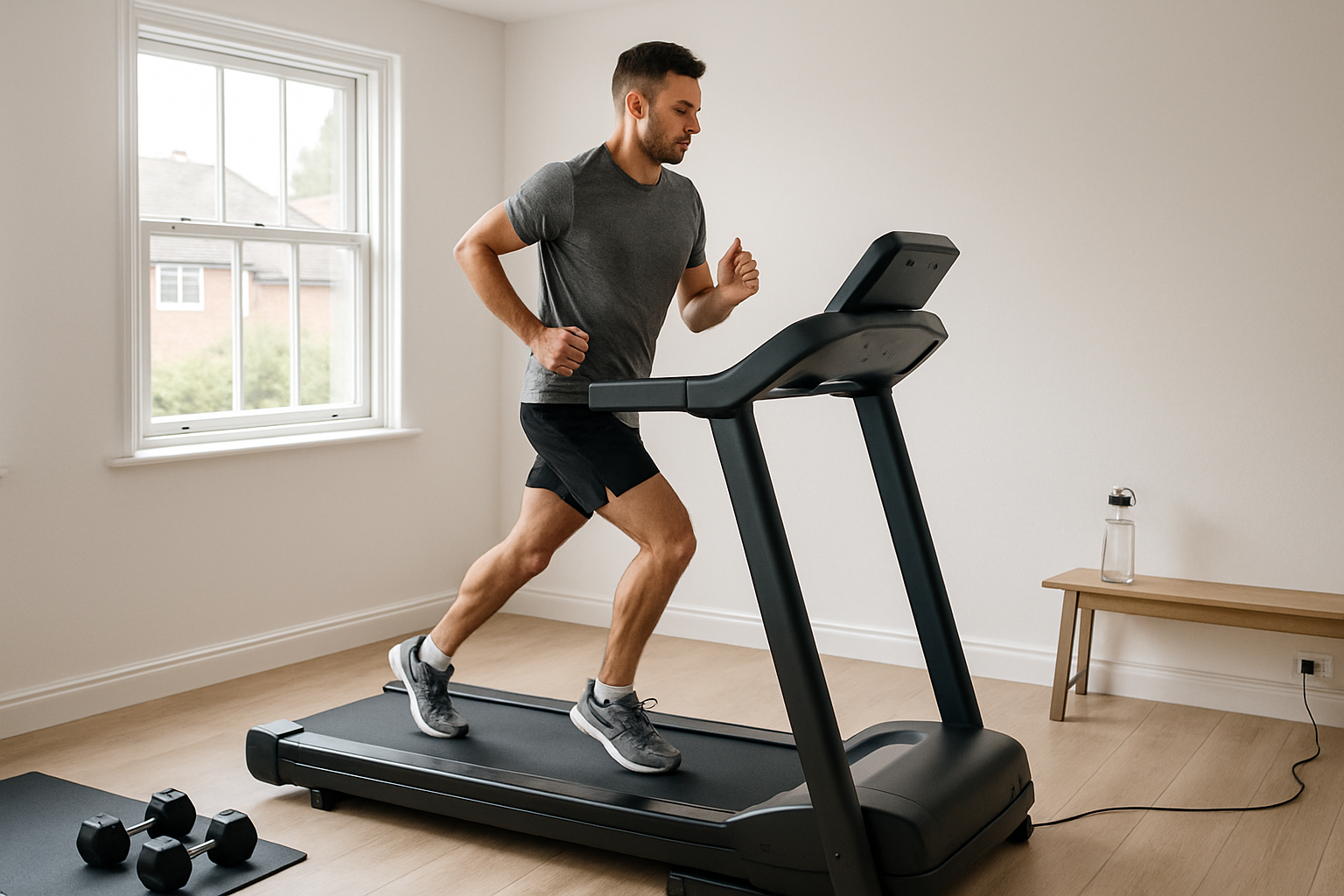
What this 10k treadmill training plan is and who it’s for
This structured 8-week schedule prepares beginners and lower-intermediate runners to complete or improve a 10k using primarily treadmill sessions. You’ll run 3–4 days a week, progress volume sensibly, and use targeted quality workouts to boost aerobic capacity and running economy.
It’s ideal if you:
- Prefer training indoors for consistency, safety, or time efficiency.
- Are coming from a 5k base or brisk-walking habit (30–40 minutes comfortably).
- Want a plan you can follow on most home treadmills without special features.
Equipment and home setup
You can complete this plan on any reliable home treadmill. Helpful features include adjustable incline (0–10%), a clear console, and quick speed controls. Place a small fan nearby, keep a water bottle within reach, and use the safety clip.
- Space/noise: Position on a firm floor or quality mat. If you live in a flat, run at moderate hours and consider softer midsole shoes to limit impact noise.
- Incline: Set 0.5–1% for most steady runs to better match outdoor metabolic cost; 2–3% for hill intervals.
- Footwear: Road running shoes with neutral or stability support as needed.
Setting up a dedicated corner helps adherence—see how to build a home gym for layout ideas and budgeting.
Training zones and pacing (RPE/HR)
Use RPE (rating of perceived exertion, 1–10) or heart rate to guide effort. If you lack an HR monitor, RPE is accurate enough for most runners.
- Easy/Recovery: RPE 3–4; conversational. ~60–70% HRmax.
- Steady/Endurance: RPE 4–5; you can talk in short sentences. ~70–78% HRmax.
- Tempo/Threshold: RPE 6–7; controlled discomfort. ~80–88% HRmax.
- Intervals: RPE 8–9; hard but repeatable. ~90–95% HRmax.
The UK Chief Medical Officers advise at least 150 minutes of moderate or 75 minutes of vigorous activity weekly, plus strength work on two days. This plan aligns with those recommendations while building towards a 10k target pace (CMO guidelines).
Glossary
- RPE: 1–10 scale of effort; 3–4 = easy, 6–7 = tempo, 8–9 = hard intervals.
- Strides: 20–30 seconds faster running with full recovery; focus on smoothness.
Warm-up and cooldown
Every run: 8–12 minutes easy jog or brisk walk, then 2–3 x 20–30s strides for quality days. Finish with 5–10 minutes easy plus light calf/hip mobility.
- Mobility ideas: ankle rocks, calf raises, hip flexor stretch, glute bridges (6–8 reps each).
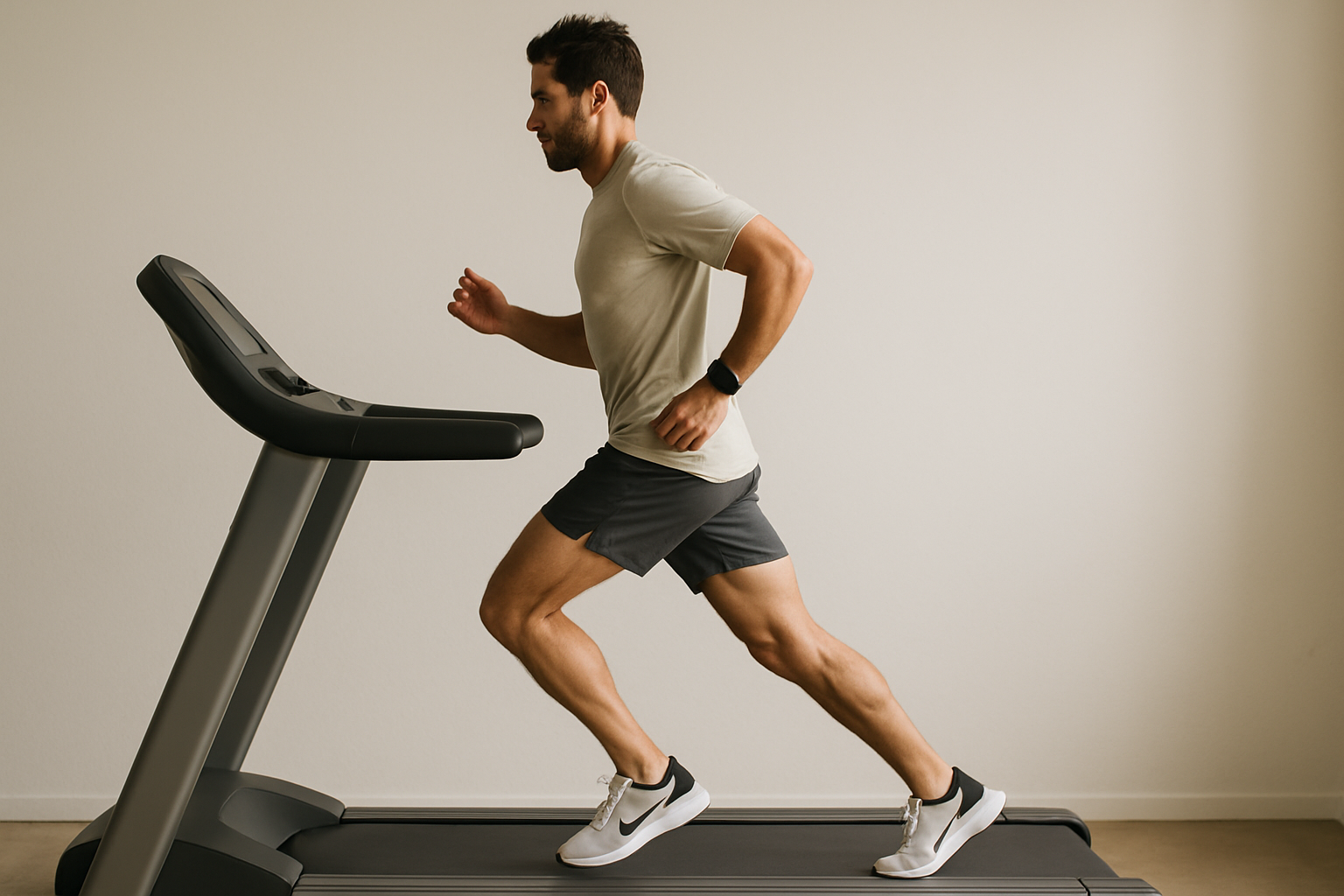
The 8-week 10k treadmill training plan
Choose Beginner or Intermediate. If in doubt, start Beginner.
Weekly structure (both levels)
- Day 1: Easy run
- Day 2: Quality (intervals or tempo)
- Day 3: Optional recovery jog or cross-training
- Day 4: Long run (easy to steady)
Beginner track
- Week 1:
- Easy 25 min @ RPE 3–4, 0.5–1% incline
- Intervals: 6 x 1 min @ RPE 7–8, 2 min easy between
- Optional: 20–25 min brisk walk or easy cycle/row
- Long run: 35 min easy
- Week 2:
- Easy 30 min
- Intervals: 7 x 1 min hard, 2 min easy
- Optional: 20–25 min cross-train
- Long run: 40 min easy
- Week 3:
- Easy 30 min
- Tempo introduction: 2 x 6 min @ RPE 6 with 3 min easy
- Optional: 25–30 min recovery jog or cross-train
- Long run: 45 min easy
- Week 4 (deload):
- Easy 25–30 min
- Intervals: 5 x 1 min @ RPE 7–8, 2 min easy
- Optional: Rest or gentle cross-train 20 min
- Long run: 35–40 min easy
- Week 5:
- Easy 30 min
- Tempo: 2 x 8 min @ RPE 6–7, 3 min easy
- Optional: 25–30 min easy or cross-train
- Long run: 50 min easy-steady (last 10 min at RPE 5)
- Week 6:
- Easy 30–35 min
- Intervals: 6 x 2 min @ RPE 8, 2 min easy
- Optional: 25–30 min easy
- Long run: 55 min easy
- Week 7:
- Easy 30 min
- Tempo: 3 x 8 min @ RPE 6–7, 2–3 min easy
- Optional: 20–25 min easy
- Long run: 60 min easy
- Week 8 (taper):
- Easy 25 min
- Sharpener: 6 x 1 min @ RPE 7–8, 2 min easy
- Rest or 20 min very easy
- 10k day: 10–12 min warm-up, then run by RPE/pacing plan; cool down well
Intermediate track
- Week 1: Easy 30 min; Intervals 6 x 2 min @ RPE 8 (90s easy); Optional 25–30 min easy; Long 45 min
- Week 2: Easy 35 min; Tempo 2 x 10 min @ RPE 6–7 (3 min easy); Optional 30 min; Long 50 min
- Week 3: Easy 35 min; Intervals 8 x 90s @ RPE 8–9 (90s easy); Optional 25–30 min; Long 55 min
- Week 4 (deload): Easy 30 min; Tempo 12 min @ RPE 6–7; Optional rest; Long 40–45 min
- Week 5: Easy 35 min; Tempo 3 x 10 min @ RPE 6–7 (2–3 min easy); Optional 25–30 min; Long 60 min (last 15 min at RPE 5)
- Week 6: Easy 35–40 min; Intervals 5 x 3 min @ RPE 8–9 (2 min easy); Optional 25 min; Long 65 min easy
- Week 7: Easy 35 min; Tempo 20 min continuous @ RPE 6–7 + 4 x 30s strides; Optional 20–25 min; Long 70 min easy
- Week 8 (taper): Easy 30 min; 6 x 1 min @ RPE 7–8; Rest/easy 20 min; 10k day (race effort)
Cross-training option (Day 3): 20–30 minutes gentle cycling, rowing, or cross-trainer at RPE 3–4. If you have a rower, compare options in our best rowing machines guide, or see our impressions in the BodyMax Oxbridge HR Air Rowing Machine review. For a compact cross-trainer/exercise bike combo, see the JLL CT100 review.
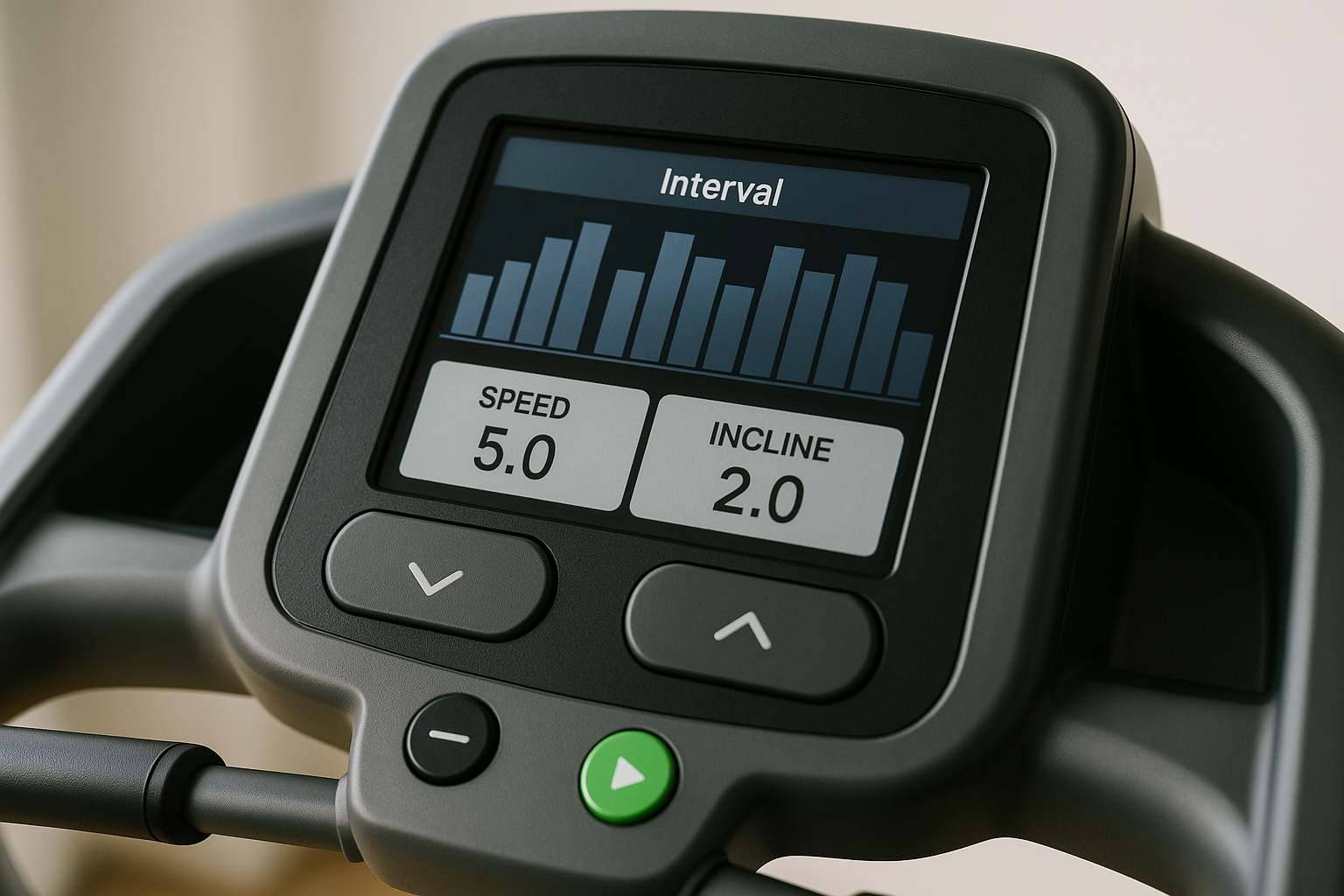
Technique cues and common mistakes
- Slight forward lean from the ankles, not the waist.
- Land softly with the foot under your hips; avoid overstriding.
- Quick, light cadence (roughly 160–180 steps/min for many runners).
- Relax shoulders and hands; keep your gaze forward.
Pro tips
- Use 0.5–1% incline for steady runs; increase to 2–3% for short hill repeats to build strength.
- Program speed keys or use small 0.1–0.2 km/h nudges to fine-tune tempo efforts.
- Place a towel over the console in tempo/long runs to reduce “clock watching.”
Common mistakes
- Skipping warm-ups and strides before quality sessions.
- Turning every easy run into a moderate one (creeping pace).
- Leaning on the rails during inclines—reduce speed instead.
- Jumping volume by more than ~10% per week, increasing injury risk (PubMed review on running injury risk).
Strength, mobility, and recovery
Two short strength sessions per week improve resilience and efficiency. 15–20 minutes is enough:
- Split squats or step-ups: 2–3 x 8–10/side
- Romanian deadlifts (dumbbells): 2–3 x 8–10
- Calf raises (straight and bent knee): 2–3 x 12–15
- Side planks or dead bugs: 2–3 x 20–30s
Recover with 7–9 hours sleep where possible and light mobility on rest days. The NHS recommends regular physical activity combined with good sleep hygiene for overall health (NHS exercise guidance).
Nutrition and hydration
- Daily protein: roughly 1.2–1.6 g/kg body mass to support recovery.
- Pre-run: light carb-based snack 60–90 minutes before quality or long runs (e.g., banana + yoghurt).
- During: for runs over 60 minutes, sip water; consider small carb intake if you’re experienced.
- Post-run: protein + carbs within 1–2 hours (e.g., eggs on toast, smoothie).
Build meals around the NHS Eatwell principles for balance (NHS Eatwell Guide).
Scaling for busy weeks and small spaces
- Pressed for time? Keep the quality session and long run; shorten the easy run by 10 minutes.
- Noisy flat? Swap one run for a cross-trainer or rower session at RPE 3–4.
- Heat issue indoors? Use a fan and cool room; reduce pace by 3–5% and increase fluids.
Troubleshooting
- Shin or calf niggles: Reduce volume by 20–30% for 1 week; add calf raises; consider an extra easy day.
- Side stitch: Ease pace, exhale fully every few breaths; avoid large meals within 2 hours of quality runs.
- Overheating: Lower room temp, add a second fan, hydrate; consider splitting long runs into 2 x 30 min AM/PM if needed.
- Boredom: Vary incline, try progression runs, or break long runs into segments (e.g., 3 x 15 min steady/easy/steady).
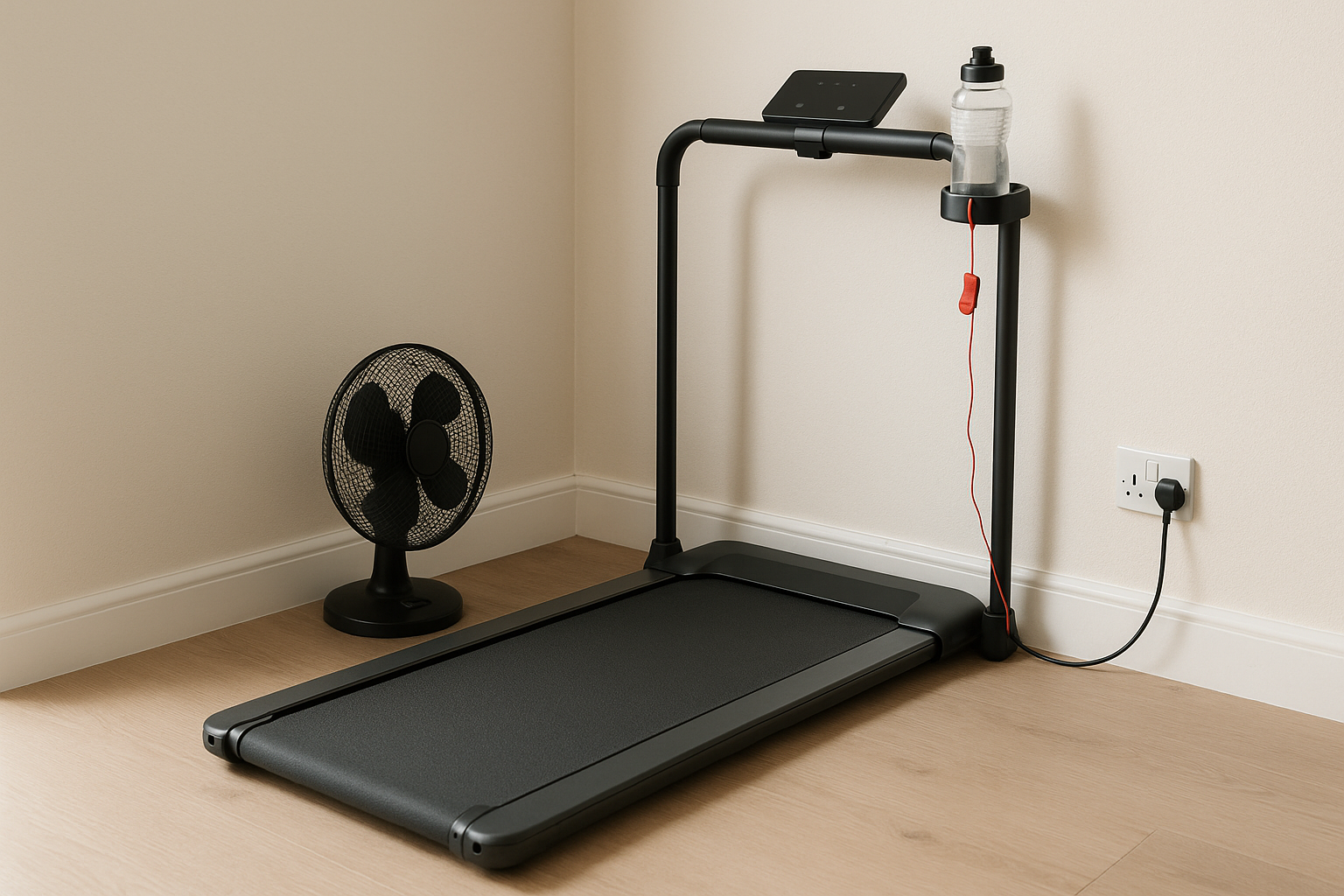
Alternatives and quick comparison
If impact is an issue, cross-trainer and rowing sessions can replace one weekly run while maintaining cardiovascular gains.
Quick comparison
- Treadmill: Specific to running; control pace/incline precisely; impact higher.
- Cross-trainer: Low-impact; good for longer easy sessions; slightly less run-specific.
- Rowing machine: Full-body; excellent aerobic stimulus; technique learning curve.
Considering a rower for cross-training days? Browse our best rowing machines guide or read the hands-on BodyMax Oxbridge HR Air Rowing Machine review. If space is tight, a hybrid like the CT100 might suit—see the JLL CT100 review.
FAQs
- What incline should I use? 0.5–1% for steady runs, 2–3% for short hills. If form deteriorates, reduce speed before dropping incline.
- How fast should my tempo be? RPE 6–7: controlled hard, talk in short phrases. If using HR, aim ~80–88% HRmax.
- Can I swap a run for cross-training? Yes—replace one easy day with 20–40 minutes on a cross-trainer or rower at RPE 3–4.
- Do I need a specific shoe? A comfortable road running shoe that matches your support needs; replace roughly every 600–800 km.
- Is 8 weeks enough? For completion and PB attempts for newer runners, yes. If you’re very new, build a base first or follow our treadmill 5k training plan then return.
- What if I miss a week? Drop back one week in the plan and rebuild; avoid cramming extra hard sessions.
- How do I avoid injuries? Progress gradually, keep easy days easy, and add calf/hip strength. Monitor niggles and reduce load early (training load and injury evidence).
Safety disclaimer
If you have any medical conditions, are pregnant, or are new to exercise, consult your GP or a qualified professional before starting. Progress gradually, prioritise good form, and stop if you feel unwell, dizzy, or experience sharp pain.
Related reading
- treadmill 5k training plan
- build a home gym
- best rowing machines
- BodyMax Oxbridge HR Air Rowing Machine review
- JLL CT100 review
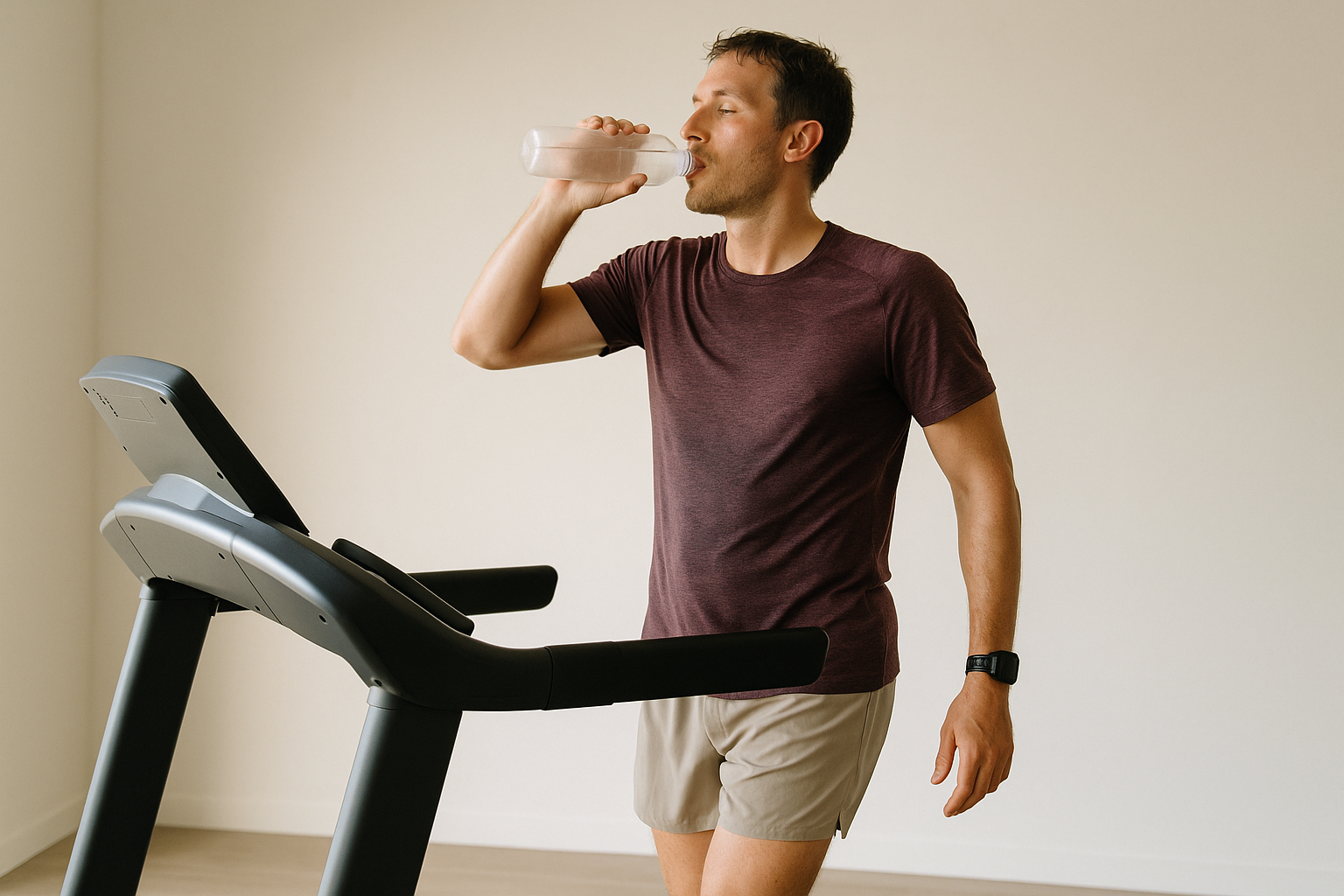
Conclusion
With three to four focused treadmill runs per week, sensible progression, and a bit of strength and mobility, you can complete—and likely PB—your next 10k from home. Keep easy days truly easy, use incline smartly, fuel well, and adjust volume if niggles pop up.
Next steps: if you’re moving up from 5k, start with our treadmill 5k training plan. If you’re adding low-impact variety, compare rowers in our best rowing machines guide, or plan your space with build a home gym.